programming is giving a set of instructions to a computer to execute.
While sometimes used interchangeably, programming and coding actually have different definitions.
- Programming is the mental process of thinking up instructions to give to a machine (like a computer).
- Coding is the process of transforming those ideas into a written language that a computer can understand.
PROGRAMMING AS COLLABORATION
The best computer programs are the ones that enable us to make things that we couldn’t do on our own, but leverage our creative capacities. We may be good at drawing, but a computer is great at doing the same task repeatedly — and quickly!
Introduction: Fundamentals of HTML
The goal of this unit is to introduce you to the fundamentals of HTML, one of the languages essential to developing websites.
After this unit, you will be able to:
- Understand how HTML is used for web development
- Use HTML to build a structure for a website
- Create tables in HTML documents
- Write clearer, more accessible HTML using Semantic HTML tags
Introduction to HTML
HTML is the skeleton of all web pages. It’s often the first language learned by developers, marketers, and designers and is core to front-end development work.
HTML provides structure to the content appearing on a website, such as images, text, or videos. Right-click on any page on the internet, choose “Inspect,” and you’ll see HTML in a panel of your screen.
HTML stands for HyperText Markup Language:
- A markup language is a computer language that defines the structure and presentation of raw text.
- In HTML, the computer can interpret raw text that is wrapped in HTML elements.
- HyperText is text displayed on a computer or device that provides access to other text through links, also known as hyperlinks. You probably clicked on a couple of hyperlinks on your way to this Codecademy course.
HTML Anatomy
HTML is composed of elements. These elements structure the webpage and define its content.
the paragraph element is made up of:
- An opening tag (
<p>) - The content (“Hello World!” text)
- A closing tag (
</p>)
Let’s quickly review each part of the element pictured:
-
HTML element (or simply, element) — a unit of content in an HTML document formed by HTML tags and the text or media it contains.
-
HTML Tag — the element name, surrounded by an opening (
<) and closing (>) angle bracket. -
Opening Tag — the first HTML tag used to start an HTML element. The tag type is surrounded by opening and closing angle brackets.
-
Content — The information (text or other elements) contained between the opening and closing tags of an HTML element.
-
Closing tag — the second HTML tag used to end an HTML element. Closing tags have a forward slash (
/) inside of them, directly after the left angle bracket.

The Body
One of the key HTML elements we use to build a webpage is the body element. Only content inside the opening and closing body tags can be displayed to the screen.
<body>
</body>HTML Structure
HTML is organized as a collection of family tree relationships. As you saw in the last exercise, we placed <p> tags within <body> tags. When an element is contained inside another element, it is considered the child of that element. The child element is said to be nested inside of the parent element.
<body>
<p>This paragraph is a child of the body</p>
</body>he <p> element is nested inside the <body> element. The <p> element is considered a child of the <body> element, and the <body> element is considered the parent. You can also see that we’ve added two spaces of indentation (using the space bar) for better readability.
<body>
<div>
<h1>Sibling to p, but also grandchild of body</h1>
<p>Sibling to h1, but also grandchild of body</p>
</div>
</body><body>
<h1>Hello World</h1>
<p>This paragraph is a child of the body element</p>
<div>
<p>This paragraph is a child of the dive element and a grandchild of the body element</p>
</div>
</body>
Headings
Headings in HTML are similar to headings in other types of media.
headings are used to describe content, like the title of a movie or an educational article.
HTML follows a similar pattern. In HTML, there are six different headings, or heading elements. Headings can be used for a variety of purposes, like titling sections, articles, or other forms of content.
The following is the list of heading elements available in HTML. They are ordered from largest to smallest in size.
<h1>— used for main headings. All other smaller headings are used for subheadings.<h2><h3><h4><h5><h6>
<body>
<h1>The Brown Bear</h1>
<h2>About Brown Bears</h2>
<h3>Species</h3>
<h3>Features</h3>
<h2>Habitat</h2>
<h3>Countries with Large Brown Bear Populations</h3>
<h3>Countries with Small Brown Bear Populations</h3>
<h2>Media</h2>
</body>
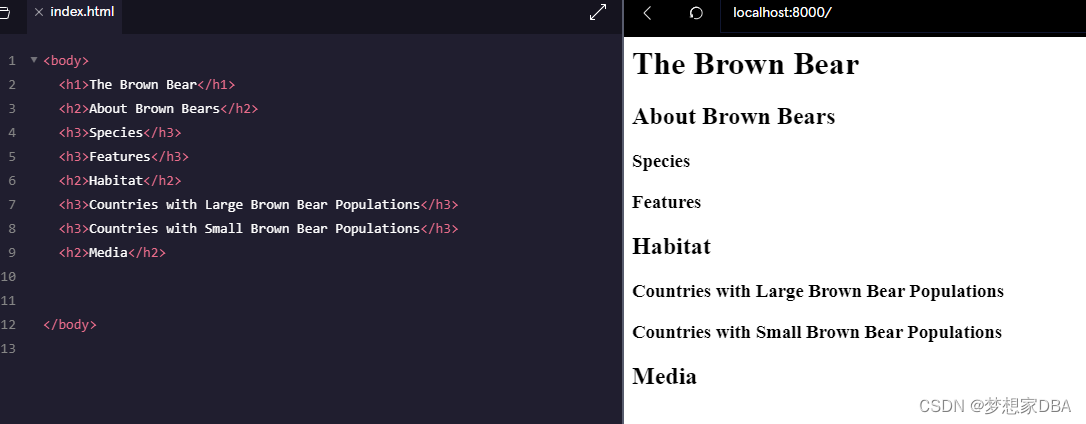
Divs
One of the most popular elements in HTML is the <div> element. <div> is short for “division” or a container that divides the page into sections.
<body>
<div>
<h1>Why use divs?</h1>
<p>Great for grouping elements!</p>
</div>
</body><div>s can contain any text or other HTML elements, such as links, images, or videos. Remember to always add two spaces of indentation when you nest elements inside of <div>s for better readability.
<body>
<h1>The Brown Bear</h1>
<div>
<h2>About Brown Bears</h2>
<h3>Species</h3>
<h3>Features</h3>
</div>
<div>
<h2>Habitat</h2>
<h3>Countries with Large Brown Bear Populations</h3>
<h3>Countries with Small Brown Bear Populations</h3>
</div>
<div>
<h2>Media</h2>
</div>
</body>

Attributes
If we want to expand an element’s tag, we can do so using an attribute. Attributes are content added to the opening tag of an element and can be used in several different ways, from providing information to changing styling. Attributes are made up of the following two parts:
- The name of the attribute
- The value of the attribute
One commonly used attribute is the id. We can use the id attribute to specify different content (such as <div>s) and is really helpful when you use an element more than once. ids have several different purposes in HTML, but for now, we’ll focus on how they can help us identify content on our page.
<div id="intro">
<h1>Introduction</h1>
</div><body>
<h1>The Brown Bear</h1>
<div id="introduction">
<h2>About Brown Bears</h2>
<h3>Species</h3>
<h3>Features</h3>
</div>
<div id="habitat">
<h2>Habitat</h2>
<h3>Countries with Large Brown Bear Populations</h3>
<h3>Countries with Small Brown Bear Populations</h3>
</div>
<div id="media">
<h2>Media</h2>
</div>
</body>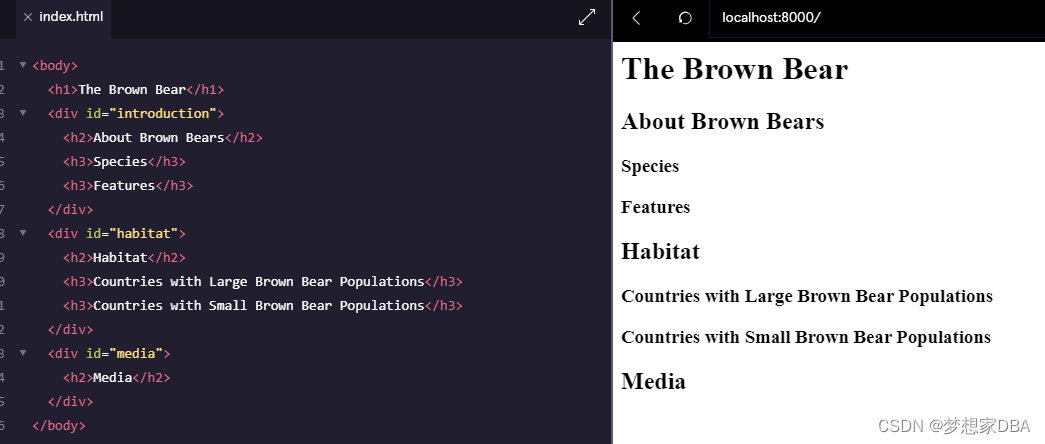
Displaying Text
If you want to display text in HTML, you can use a paragraph or span:
- Paragraphs (<p>)contain a block of plain text.
- <span> contains short pieces of text or other HTML. They are used to separate small pieces of content that are on the same line as other content.
<div>
<h1>Technology</h1>
</div>
<div>
<p><span>Self-driving cars</span> are anticipated to replace up to 2 million jobs over the next two decades.</p>
</div>It’s best to use a <span> element when you want to target a specific piece of content that is inline, or on the same line as other text. If you want to divide your content into blocks, it’s better to use a <div>.
<body>
<h1>The Brown Bear</h1>
<div id="introduction">
<h2>About Brown Bears</h2>
<p>The brown bear (Ursus arctos) is native to parts of northern Eurasia and North America. Its conservation status is currently Least Concern. There are many subspecies within the brown bear species, including the Atlas bear and the Himalayan brown bear.</p>
<h3>Species</h3>
<h3>Features</h3>
<p>Brown bears are not always completely brown. Some can be reddish or yellowish. They have very large, curved claws and huge paws. Male brown bears are often 30% larger than female brown bears. They can range from 5 feet to 9 feet from head to toe.</p>
</div>
<div id="habitat">
<h2>Habitat</h2>
<h3>Countries with Large Brown Bear Populations</h3>
<h3>Countries with Small Brown Bear Populations</h3>
<p>Some countries with smaller brown bear populations include Armenia, Belarus, Bulgaria, China, Finland, France, Greece, India, Japan, Nepal, Poland, Romania, Slovenia, Turkmenistan, and Uzbekistan.</p>
</div>
<div id= "media">
<h2>Media</h2>
</div>
</body>
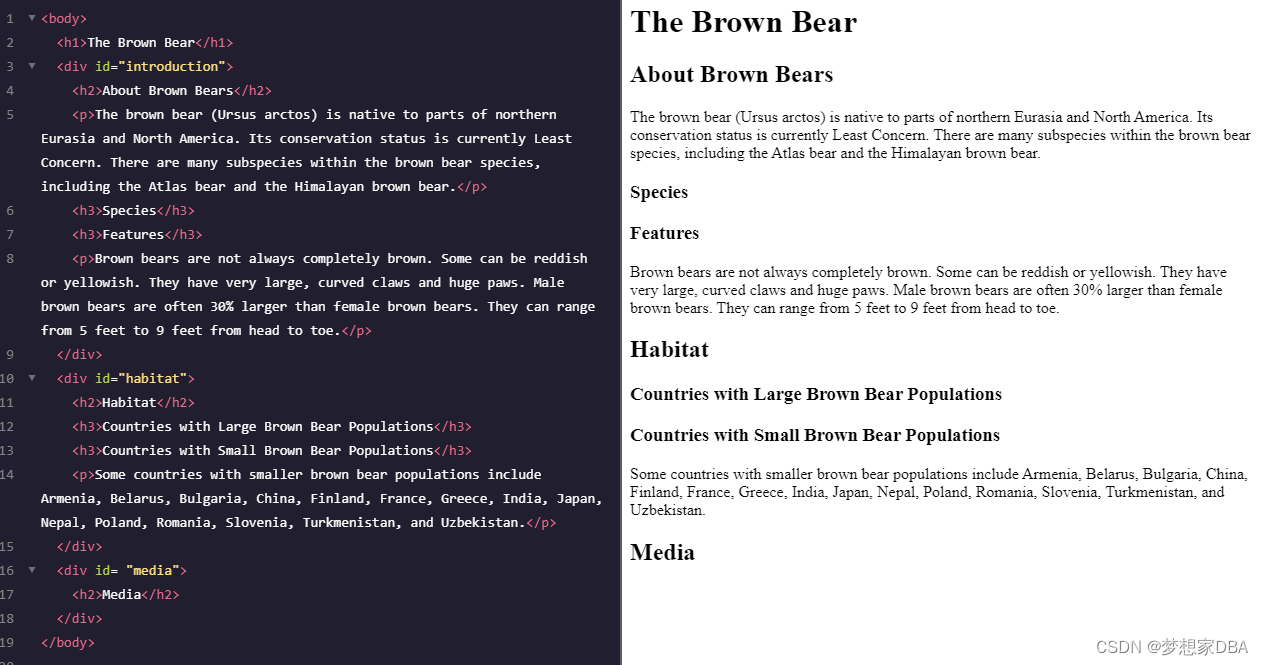
Styling Text
You can also style text using HTML tags. The <em> tag emphasizes text, while the <strong> tag highlights important text.
- The
<em>tag will generally render as italic emphasis. - The
<strong>will generally render as bold emphasis.
<p><strong>The Nile River</strong> is the <em>longest</em> river in the world, measuring over 6,850 kilometers long (approximately 4,260 miles).</p><body>
<h1>The Brown Bear</h1>
<div id="introduction">
<h2>About Brown Bears</h2>
<p>The brown bear (<em>Ursus arctos</em>) is native to parts of northern Eurasia and North America. Its conservation status is currently <strong>Least Concern</strong>. There are many subspecies within the brown bear species, including the Atlas bear and the Himalayan brown bear.</p>
<h3>Species</h3>
<h3>Features</h3>
<p>Brown bears are not always completely brown. Some can be reddish or yellowish. They have very large, curved claws and huge paws. Male brown bears are often 30% larger than female brown bears. They can range from 5 feet to 9 feet from head to toe.</p>
</div>
<div id="habitat">
<h2>Habitat</h2>
<h3>Countries with Large Brown Bear Populations</h3>
<h3>Countries with Small Brown Bear Populations</h3>
<p>Some countries with smaller brown bear populations include Armenia, Belarus, Bulgaria, China, Finland, France, Greece, India, Japan, Nepal, Poland, Romania, Slovenia, Turkmenistan, and Uzbekistan.</p>
</div>
<div id="media">
<h2>Media</h2>
</div>
</body>

Line Breaks
The spacing between code in an HTML file doesn’t affect the positioning of elements in the browser. If you are interested in modifying the spacing in the browser, you can use HTML’s line break element: <br>.
<p>The Nile River is the longest river <br> in the world, measuring over 6,850 <br> kilometers long (approximately 4,260 <br> miles).</p>The code in the example above will result in an output that looks like the following:
The Nile River is the longest river
in the world, measuring over 6,850
kilometers long (approximately 4,260
<body>
<h1>The Brown Bear</h1>
<div id="introduction">
<h2>About Brown Bears</h2>
<p>The brown bear (<em>Ursus arctos</em>) is native to parts of northern Eurasia and North America. Its conservation status is currently <strong>Least Concern</strong>.<br><br>There are many subspecies within thebrown bear species, including the Atlas bear and the Himalayan brown bear</p>
<h3>Species</h3>
<h3>Features</h3>
<p>Brown bears are not always completely brown. Some can be reddish or yellowish. They have very large, curved claws and huge paws. Male brown bears are often 30% larger than female brown bears. They can range from 5 feet to 9 feet from head to toe.</p>
</div>
<div id="habitat">
<h2>Habitat</h2>
<h3>Countries with Large Brown Bear Populations</h3>
<h3>Countries with Small Brown Bear Populations</h3>
<p>Some countries with smaller brown bear populations include Armenia, Belarus, Bulgaria, China, Finland, France, Greece, India, Japan, Nepal, Poland, Romania, Slovenia, Turkmenistan, and Uzbekistan.</p>
</div>
<div id="media">
<h2>Media</h2>
</div>
</body>

Unordered Lists
In HTML, you can use an unordered list tag (<ul>) to create a list of items in no particular order. An unordered list outlines individual list items with a bullet point.
The <ul> element should not hold raw text and won’t automatically format raw text into an unordered list of items. Individual list items must be added to the unordered list using the <li> tag. The <li> or list item tag is used to describe an item in a list.
<ul>
<li>Limes</li>
<li>Tortillas</li>
<li>Chicken</li>
</ul>In the example above, the list was created using the <ul> tag and all individual list items were added using <li> tags.
The output will look like this:
- Limes
- Tortillas
- Chicken
<body>
<h1>The Brown Bear</h1>
<div id="introduction">
<h2>About Brown Bears</h2>
<p>The brown bear (<em>Ursus arctos</em>) is native to parts of northern Eurasia and North America. Its conservation status is currently <strong>Least Concern</strong>. <br><br> There are many subspecies within the brown bear species, including the Atlas bear and the Himalayan brown bear.</p>
<h3>Species</h3>
<ul>
<li>Arctos</li>
<li>Collarus</li>
<li>Horribilis</li>
<li>Nelsoni(extinct)</li>
</ul>
<h3>Features</h3>
<p>Brown bears are not always completely brown. Some can be reddish or yellowish. They have very large, curved claws and huge paws. Male brown bears are often 30% larger than female brown bears. They can range from 5 feet to 9 feet from head to toe.</p>
</div>
<div id="habitat">
<h2>Habitat</h2>
<h3>Countries with Large Brown Bear Populations</h3>
<h3>Countries with Small Brown Bear Populations</h3>
<p>Some countries with smaller brown bear populations include Armenia, Belarus, Bulgaria, China, Finland, France, Greece, India, Japan, Nepal, Poland, Romania, Slovenia, Turkmenistan, and Uzbekistan.</p>
</div>
<div id="media">
<h2>Media</h2>
</div>
</body>
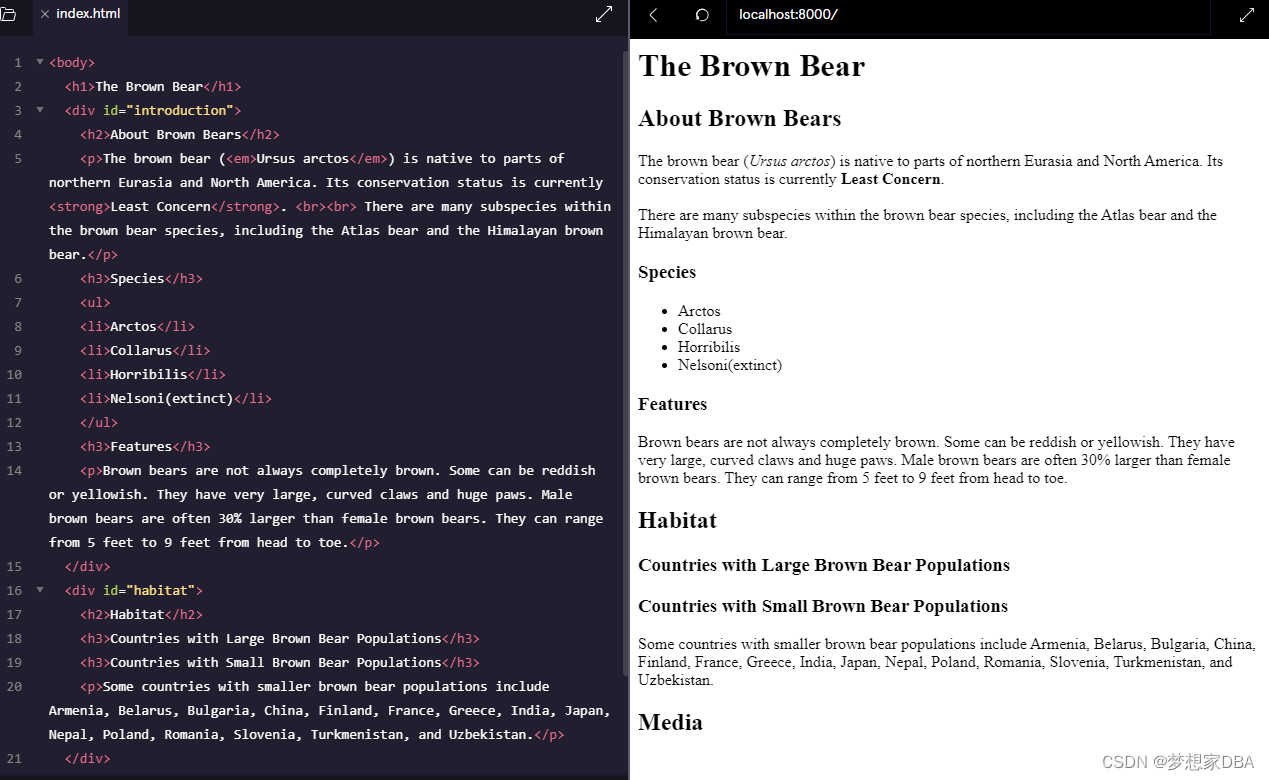
Ordered Lists
Ordered lists (<ol>) are like unordered lists, except that each list item is numbered. They are useful when you need to list different steps in a process or rank items for first to last.
You can create the ordered list with the <ol> tag and then add individual list items to the list using <li> tags.
<ol>
<li>Preheat the oven to 350 degrees.</li>
<li>Mix whole wheat flour, baking soda, and salt.</li>
<li>Cream the butter, sugar in separate bowl.</li>
<li>Add eggs and vanilla extract to bowl.</li>
</ol>The output will look like this:
- Preheat the oven to 350 degrees.
- Mix whole wheat flour, baking soda, and salt.
- Cream the butter, sugar in separate bowl.
- Add eggs and vanilla extract to bowl.
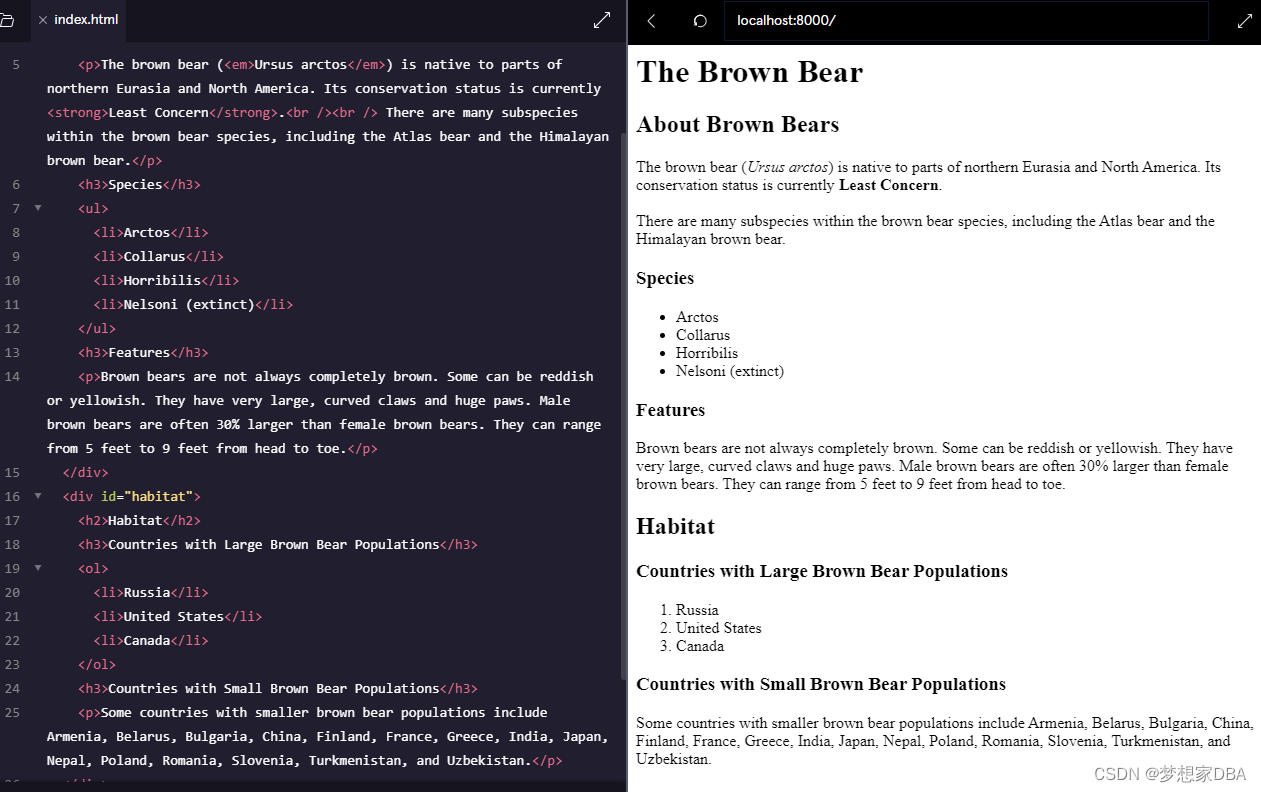
Images
All of the elements you’ve learned about so far (headings, paragraphs, lists, and spans) share one thing in common: they’re composed entirely of text!
The <img> tag allows you to add an image to a web page. Most elements require both opening and closing tags, but the <img> tag is a self-closing tag. Note that the end of the <img> tag has a forward slash /. Self-closing tags may include or omit the final slash — both will render properly.
<img src="image-location.jpg" />The <img> tag has a required attribute called src. The src attribute must be set to the image’s source, or the location of the image. In this case, the value of src must be the uniform resource locator (URL) of the image. A URL is the web address or local address where a file is stored.
<body>
<h1>The Brown Bear</h1>
<div id="introduction">
<h2>About Brown Bears</h2>
<p>The brown bear (<em>Ursus arctos</em>) is native to parts of northern Eurasia and North America. Its conservation status is currently <strong>Least Concern</strong>.<br /><br /> There are many subspecies within the brown bear species, including the Atlas bear and the Himalayan brown bear.</p>
<h3>Species</h3>
<ul>
<li>Arctos</li>
<li>Collarus</li>
<li>Horribilis</li>
<li>Nelsoni (extinct)</li>
</ul>
<h3>Features</h3>
<p>Brown bears are not always completely brown. Some can be reddish or yellowish. They have very large, curved claws and huge paws. Male brown bears are often 30% larger than female brown bears. They can range from 5 feet to 9 feet from head to toe.</p>
</div>
<div id="habitat">
<h2>Habitat</h2>
<h3>Countries with Large Brown Bear Populations</h3>
<ol>
<li>Russia</li>
<li>United States</li>
<li>Canada</li>
</ol>
<h3>Countries with Small Brown Bear Populations</h3>
<p>Some countries with smaller brown bear populations include Armenia, Belarus, Bulgaria, China, Finland, France, Greece, India, Japan, Nepal, Poland, Romania, Slovenia, Turkmenistan, and Uzbekistan.</p>
</div>
<div id="media">
<h2>Media</h2>
<img src="courses/web-101/web101-image_brownbear.jpg"/>
</div>
</body>
Image Alts
Part of being an exceptional web developer is making your site accessible to users of all backgrounds. In order to make the Web more inclusive, we need to consider what happens when assistive technologies such as screen readers come across image tags.
The alt attribute, which means alternative text, brings meaning to the images on our sites. The alt attribute can be added to the image tag just like the src attribute. The value of alt should be a description of the image.
<img src="#" alt="A field of yellow sunflowers" />The alt attribute also serves the following purposes:
- If an image fails to load on a web page, a user can mouse over the area originally intended for the image and read a brief description of the image. This is made possible by the description you provide in the
altattribute. - Visually impaired users often browse the web with the aid of screen reading software. When you include the
altattribute, the screen reading software can read the image’s description out loud to the visually impaired user. - The
altattribute also plays a role in Search Engine Optimization (SEO), because search engines cannot “see” the images on websites as they crawl the internet. Having descriptivealtattributes can improve the ranking of your site.
videos
In addition to images, HTML also supports displaying videos. Like the <img> element, the <video> element requires a src attribute with a link to the video source. Unlike the <img> element however, the <video> element requires an opening and a closing tag.
<video src="myVideo.mp4" width="320" height="240" controls>
Video not supported
</video>the video source (src) is "myVideo.mp4". The source can be a video file that is hosted alongside your webpage, or a URL that points to a video file hosted on another webpage.
After the src attribute, the width and height attributes are used to set the size of the video displayed in the browser. The controls attribute instructs the browser to include basic video controls such as pausing and playing.
The text, Video not supported, between the opening and closing video tags will only be displayed if the browser is unable to load the video.
<body>
<h1>The Brown Bear</h1>
<div id="introduction">
<h2>About Brown Bears</h2>
<p>The brown bear (<em>Ursus arctos</em>) is native to parts of northern Eurasia and North America. Its conservation status is currently <strong>Least Concern</strong>.<br /><br /> There are many subspecies within the brown bear species, including the Atlas bear and the Himalayan brown bear.</p>
<h3>Species</h3>
<ul>
<li>Arctos</li>
<li>Collarus</li>
<li>Horribilis</li>
<li>Nelsoni (extinct)</li>
</ul>
<h3>Features</h3>
<p>Brown bears are not always completely brown. Some can be reddish or yellowish. They have very large, curved claws and huge paws. Male brown bears are often 30% larger than female brown bears. They can range from 5 feet to 9 feet from head to toe.</p>
</div>
<div id="habitat">
<h2>Habitat</h2>
<h3>Countries with Large Brown Bear Populations</h3>
<ol>
<li>Russia</li>
<li>United States</li>
<li>Canada</li>
</ol>
<h3>Countries with Small Brown Bear Populations</h3>
<p>Some countries with smaller brown bear populations include Armenia, Belarus, Bulgaria, China, Finland, France, Greece, India, Japan, Nepal, Poland, Romania, Slovenia, Turkmenistan, and Uzbekistan.</p>
</div>
<div id="media">
<h2>Media</h2>
<img src="/courses/web-101/web101-image_brownbear.jpg" alt="A Brown Bear"/>
<video src="/courses/freelance-1/unit-1/lesson-2/htmlcss1-vid_brown-bear.mp4" width="320" height="240" controls> video not supported</video>
</div>
</body>
Let’s review:
- HTML stands for HyperText Markup Language and is used to create the structure and content of a webpage.
- Most HTML elements contain opening and closing tags with raw text or other HTML tags between them.
- HTML elements can be nested inside other elements. The enclosed element is the child of the enclosing parent element.
- Any visible content should be placed within the opening and closing
<body>tags. - Headings and sub-headings,
<h1>to<h6>tags, are used to provide titles for sections of content. <p>,<span>and<div>tags specify text or blocks.- The
<em>and<strong>tags are used to emphasize text. - Line breaks are created with the
<br>tag. - Ordered lists (
<ol>) are numbered and unordered lists (<ul>) are bulleted. - Images (
<img>) and videos (<video>) can be added by linking to an existing source.






















 593
593











 被折叠的 条评论
为什么被折叠?
被折叠的 条评论
为什么被折叠?








